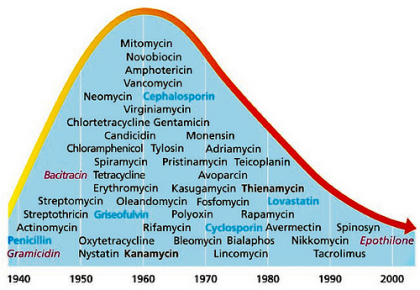Nope, I did not mis-spell THE search engine.
A googol is a very huge number. It is actually 10100 (which is 1 followed by 100 zeroes).
The term was popularized by Edward Kasner. On a walk with his nephews, Milton and Edwin Sirotta, Kasner asked for their ideas for a name for a very large number. Nine-year-old Milton suggested "googol."
Larry Page and Sergey Brin, the founders of Google, named their search engine after the term googol.
There is also googolplex - an even bigger number. A googolplex is equals to 10googol (which is 1 followed by a googol zeroes).
Incidentally, the company headquarters for Google is known as the Googleplex (most likely a combination of Google and complex).
Thursday, June 26, 2008
Wednesday, June 11, 2008
Do You Know What is Antibiotic Resistance?
In my previous post regarding bacterial vs. viral infection, I touched a little on the emergence of antibiotic resistance. So, what exactly is antibiotic resistance?
First, we need to establish what is an antibiotic. Antibiotics are medicines that fight (or prevent) infections caused by bacteria. Antibiotics cannot fight infections caused by viruses. Antibiotics have been used extensively in the fight against infectious diseases.
However, because it is used so much (and sometimes inappropriately), bacteria are quickly adapting and becoming resistant to antibiotics.
The following information from the website of the Center for Disease Control and Prevention (CDC) describes how bacteria becomes resistant to antibiotics:
Antibiotics kill or inhibit the growth of susceptible bacteria. Sometimes one of the bacteria survives because it has the ability to neutralize or evade the effect of the antibiotic; that one bacterium can then multiply and replace all the bacteria that were killed off. Exposure to antibiotics therefore provides selective pressure, which makes the surviving bacteria more likely to be resistant. In addition, bacteria that were at one time susceptible to an antibiotic can acquire resistance through mutation of their genetic material or by acquiring pieces of DNA that code for the resistance properties from other bacteria.
Because of antibiotic resistance, diseases are becoming harder to treat using conventional antibiotics. Not only that, they are becoming more virulent, causing widespread infections. Newer and more expensive antibiotics have to be used to treat these resistant bacteria. In fact, the bacteria are adapting faster than we can develop new antibiotics! This graph clearly shows that we are slowing down in the discovery of new antibiotics.
 So, what can we possibly do to help prevent this health care disaster? Here are some recommendations from the CDC:
So, what can we possibly do to help prevent this health care disaster? Here are some recommendations from the CDC:
First, we need to establish what is an antibiotic. Antibiotics are medicines that fight (or prevent) infections caused by bacteria. Antibiotics cannot fight infections caused by viruses. Antibiotics have been used extensively in the fight against infectious diseases.
However, because it is used so much (and sometimes inappropriately), bacteria are quickly adapting and becoming resistant to antibiotics.
The following information from the website of the Center for Disease Control and Prevention (CDC) describes how bacteria becomes resistant to antibiotics:
Antibiotics kill or inhibit the growth of susceptible bacteria. Sometimes one of the bacteria survives because it has the ability to neutralize or evade the effect of the antibiotic; that one bacterium can then multiply and replace all the bacteria that were killed off. Exposure to antibiotics therefore provides selective pressure, which makes the surviving bacteria more likely to be resistant. In addition, bacteria that were at one time susceptible to an antibiotic can acquire resistance through mutation of their genetic material or by acquiring pieces of DNA that code for the resistance properties from other bacteria.
Because of antibiotic resistance, diseases are becoming harder to treat using conventional antibiotics. Not only that, they are becoming more virulent, causing widespread infections. Newer and more expensive antibiotics have to be used to treat these resistant bacteria. In fact, the bacteria are adapting faster than we can develop new antibiotics! This graph clearly shows that we are slowing down in the discovery of new antibiotics.
 So, what can we possibly do to help prevent this health care disaster? Here are some recommendations from the CDC:
So, what can we possibly do to help prevent this health care disaster? Here are some recommendations from the CDC:- Do not take an antibiotic for a viral infection like a cold, a cough or the flu.
- Take an antibiotic exactly as the doctor tells you. Do not skip doses. Complete the prescribed course of treatment, even if you are feeling better.
- Do not save any antibiotics for the next time you get sick. Discard any leftover medication once you have completed your prescribed course of treatment.
- Do not take antibiotics prescribed for someone else. The antibiotic may not be appropriate for your illness. Taking the wrong medicine may delay correct treatment and allow bacteria to multiply.
- Antibiotic prescriptions in outpatient settings can be reduced dramatically - without adversely affecting patient health - by not prescribing antibiotics for viral illnesses, such as colds, most sore throats, coughs, bronchitis, and the flu.
- Do not demand antibiotics when a healthcare provider has determined they are not needed.
- Talk with your healthcare provider about antibiotic resistance.
- Wikipedia - Antibiotic Resistance
- CDC - About Antibiotic Resistance
- WHO - Antimicrobial Resistance
- Alliance for the Prudent Use of Antibiotics
- SciDev.Net - Antibiotic Resistance FAQs
Subscribe to:
Posts (Atom)